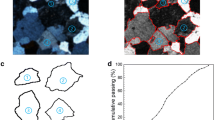Abstract
This paper presents a new procedure to create numerical models considering grain shape and size as well as pore size in an explicit and stochastic equivalent manner. Four shape factors are introduced to reproduce shape and size of grains and pores. Thin sections are used to analyze grain shape and pore size of rock specimen. First, a particle-based numerical model is set up by best fitted clumps from a shape library according to thin sections. Finally, an equivalent Voronoi-based discrete element model is set up based on the superimposed particle model. Uniaxial compression and tensile tests are simulated for validation. Both tests indicate that grain boundaries and pores provide preferred paths of weakness for crack propagation, but they also reveal significant differences in terms of intra- and inter-granular fracturing.






















Similar content being viewed by others
References
Bass JD (2013) Elasticity of minerals, glasses, and melts. In: Ahrens TJ (ed) Mineral physics & crystallography: a handbook of physical constants. American Geophysical Union, Washington, DC, pp 45–63
Bolander JE, Sukumar N (2005) Irregular lattice model for quasistatic crack propagation. Phys Rev B 71(9):094106
Chao H, Jie B, Somnath G (2007) Micromechanical and macroscopic models of ductile fracture in particle reinforced metallic materials. Model Simul Mater Sci Eng 15(4):S377
Chen W, Konietzky H (2014) Simulation of heterogeneity, creep, damage and lifetime for loaded brittle rocks. Tectonophysics 633:164–175
Chen SG, Zhao J (1998) A study of UDEC modelling for blast wave propagation in jointed rock masses. Int J Rock Mech Min Sci 35(1):93–99
Chen W, Konietzky H, Abbas SM (2015) Numerical simulation of time-independent and -dependent fracturing in sandstone. Eng Geol 193:118–131
Christodoulou I, Tan PJ (2013) Crack initiation and fracture toughness of random Voronoi honeycombs. Eng Fract Mech 104:140–161
Correns CW (1969) Crystal physics. In: Introduction to mineralogy: crystallography and petrology, Springer, Berlin, pp 101–161. doi:10.1007/978-3-642-87134-4_3
Cox MR, Budhu M (2008) A practical approach to grain shape quantification. Eng Geol 96(1–2):1–16
Eberhardt E, Stimpson B, Stead D (1999) Effects of grain size on the initiation and propagation thresholds of stress-induced brittle fractures. Rock Mech Rock Eng 32(2):81–99
Fakhimi A, Alavi Gharahbagh E (2011) Discrete element analysis of the effect of pore size and pore distribution on the mechanical behavior of rock. Int J Rock Mech Min Sci 48(1):77–85
Fredrich JT, Evans B, Wong T-F (1990) Effect of grain size on brittle and semibrittle strength: implications for micromechanical modelling of failure in compression. J Geophys Res Solid Earth 95(B7):10907–10920
Groh U, Konietzky H, Walter K, Herbst M (2011) Damage simulation of brittle heterogeneous materials at the grain size level. Theor Appl Fract Mech 55(1):31–38
Itasca (2010) UDEC-manuals. Itasca Consulting Group Inc, Minneapolis
ImageJ (https://imagej.nih.gov/ij/) Image processing and analysis in Java, an open source soft by USA National Institutes of Health
Kazerani T (2013) Effect of micromechanical parameters of microstructure on compressive and tensile failure process of rock. Int J Rock Mech Min Sci 64:44–55
Lan H, Martin CD, Hu B (2010) Effect of heterogeneity of brittle rock on micromechanical extensile behavior during compression loading. J Geophys Res Solid Earth 115(B1):B01202
Lindqvist JE, Åkesson U, Malaga K (2007) Microstructure and functional properties of rock materials. Mater Charact 58(11–12):1183–1188
Liu HY, Roquete M, Kou SQ, Lindqvist PA (2004) Characterization of rock heterogeneity and numerical verification. Eng Geol 72(1–2):89–119
Moorthy S, Ghosh S (1998) A Voronoi cell finite element model for particle cracking in elastic–plastic composite materials. Comput Methods Appl Mech Eng 151(3–4):377–400
Olsson WA (1974) Grain size dependence of yield stress in marble. J Geophys Res 79(32):4859–4862
Palchik V (1999) Influence of porosity and elastic modulus on uniaxial compressive strength in soft brittle porous sandstones. Rock Mech Rock Eng 32(4):303–309
Paterson MS (1958) Experimental deformation and faulting in Wombeyan marble. Bull Geol Soc Am 69:465–476
Rice RW (1989) Relation of tensile strength-porosity effects in ceramics to porosity dependence of Young’s modulus and fracture energy, porosity character and grain size. Mater Sci Eng A 112:215–224
Tan X, Konietzky H, Frühwirt T, Dan D (2015) Brazilian tests on transversely isotropic rocks: laboratory testing and numerical simulations. Rock Mech Rock Eng 48(4):1341–1351
Tan X, Konietzky H, Chen W (2016) Numerical simulation of heterogeneous rock using discrete element model based on digital image processing. Rock Mech Rock Eng 49(12):4957–4964
Wadell H (1935) Volume, shape, and roundness of quartz particles. J Geol 43(3):250–280
Wong TF (1982) Micromechanics of faulting in Westerly granite. Int J Rock Mech Min Sci Geomech Abstr 19(2):49–64
Wong RHC, Chau KT, Wang P (1996) Microcracking and grain size effect in Yuen Long marbles. Int J Rock Mech Min Sci Geomech Abstr 33(5):479–485
Xiao F, Yin X (2016) Geometry models of porous media based on Voronoi tessellations and their porosity-permeability relations. Comput Math Appl 72(2):328–348. doi:10.1016/j.camwa.2015.09.009
Zorlu K, Gokceoglu C, Ocakoglu F, Nefeslioglu HA, Acikalin S (2008) Prediction of uniaxial compressive strength of sandstones using petrography-based models. Eng Geol 96(3–4):141–158
Acknowledgements
The first author would like to thank the Chinese Scholarship Council for its financial support provided for his Ph.D study at TU Bergakademie Freiberg, Germany. Special thanks to Mr. Jörn Wichert and Mr. Martin Herbst for technical supporting. And thanks to Mr. Tom Weichmann, Mrs. Beatrice Tauch, and Mr. Gerd Münzberger for help during lab testing.
Author information
Authors and Affiliations
Corresponding author
Rights and permissions
About this article
Cite this article
Li, J., Konietzky, H. & Frühwirt, T. Voronoi-Based DEM Simulation Approach for Sandstone Considering Grain Structure and Pore Size. Rock Mech Rock Eng 50, 2749–2761 (2017). https://doi.org/10.1007/s00603-017-1257-4
Received:
Accepted:
Published:
Issue Date:
DOI: https://doi.org/10.1007/s00603-017-1257-4




